2024
Agenda | Flyer 1 | Flyer 2 | Flyer 3 | Flyer 4
Ana-Sofia Barrera
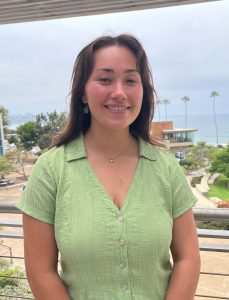 Over the summer, I looked into utilizing eDNA barcoding, with members of the Decima lab, as a viable method for pteropod analysis. We aimed to create a protocol for estimating zooplankton
Over the summer, I looked into utilizing eDNA barcoding, with members of the Decima lab, as a viable method for pteropod analysis. We aimed to create a protocol for estimating zooplankton
community composition and pteropod abundance population dynamics using EtOH-preserved CalCOFI samples from the Pelagic Invertebrate Collection here at Scripps. For DNA extractions, we tested the reliability of centrifuging, and the initial results demonstrated that roughly 40% of the samples had enough DNA present for downstream applications. Likewise, we were able to develop a viable species-specific primer for L. helicina pending in-lab testing.
Mentors: Anya Stajner, CCE Grad Student and Dr. Moira Decima, CCE Co-PI
Ainsleigh Lloyd
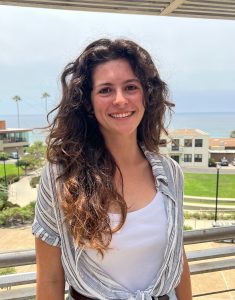 Ainsleigh Lloyd investigated goose-beaked whale kinematics by calculating their small-scale rotations from acoustic tag data. She started by extracting the tag’s magnetometer and accelerometer data and annotating it for specific whale behaviors in MATLAB. Using the values from her annotations, she was able to calculate the rotations of the tag frame, and then mathematically convert the tag frame to obtain the rotations of the whale itself. Such rotations were converted both into Euler angles and quaternions, both of which are useful quantitative data to add to goose-beaked whale population density models.
Ainsleigh Lloyd investigated goose-beaked whale kinematics by calculating their small-scale rotations from acoustic tag data. She started by extracting the tag’s magnetometer and accelerometer data and annotating it for specific whale behaviors in MATLAB. Using the values from her annotations, she was able to calculate the rotations of the tag frame, and then mathematically convert the tag frame to obtain the rotations of the whale itself. Such rotations were converted both into Euler angles and quaternions, both of which are useful quantitative data to add to goose-beaked whale population density models.
Mentors: Drs. J. Hildebrand and S. Baumann-Pickering, Staff Researcher L. Baggett
Lana Lubecke
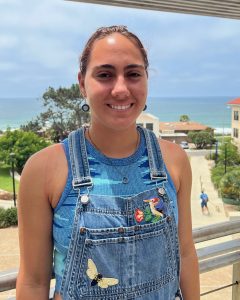 Lana Lubecke adapted the particle-tracking model OpenDrift to be used in conjunction with MIT's general circulation model (MIT gcm) to estimate the advection of DDT of the Palos Verdes Shelf and in the San Pedro Basin. She implemented a Stokes Law terminal velocity calculation and bottom stress-based resuspension condition to make OpenDrift more physically accurate. The results showed that OpenDrift can be effectively implemented using input from MITgcm to model DDT movement.
Lana Lubecke adapted the particle-tracking model OpenDrift to be used in conjunction with MIT's general circulation model (MIT gcm) to estimate the advection of DDT of the Palos Verdes Shelf and in the San Pedro Basin. She implemented a Stokes Law terminal velocity calculation and bottom stress-based resuspension condition to make OpenDrift more physically accurate. The results showed that OpenDrift can be effectively implemented using input from MITgcm to model DDT movement.
Mentors: Drs. Art Miller and SARAH GILLE
Soleil Michaud
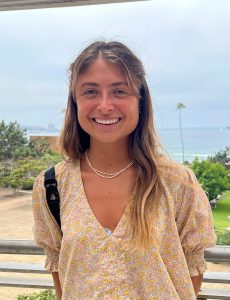 Soleil Michaud spent the summer working towards creating a protocol to extract DNA from formalin preserved Calanus Pacificus samples with the purpose of creating a time series for both C. Pacificus and Vibrio spp. population dynamics. She was provided samples from CalCOFI via the Pelagic Invertebrate Collection dating back to the 1980’s. Her initial results demonstrated that DNA from both C. pacificus and Vibrio spp. can be extracted from these preserved samples for up to 40 years and maybe more. She will continue working with Dr. Dinasquet over the school year as a volunteer to further optimize this protocol and further these results.
Soleil Michaud spent the summer working towards creating a protocol to extract DNA from formalin preserved Calanus Pacificus samples with the purpose of creating a time series for both C. Pacificus and Vibrio spp. population dynamics. She was provided samples from CalCOFI via the Pelagic Invertebrate Collection dating back to the 1980’s. Her initial results demonstrated that DNA from both C. pacificus and Vibrio spp. can be extracted from these preserved samples for up to 40 years and maybe more. She will continue working with Dr. Dinasquet over the school year as a volunteer to further optimize this protocol and further these results.
Mentor: Dr. J. Dinasquet, CCE Associate
Abigail Severance
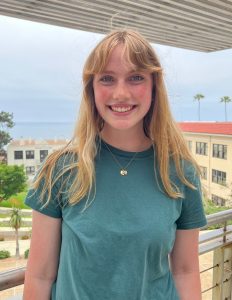 Abigail Severance measured strengths of organic iron-binding ligands in surface seawater samples from the Pupcycle Cruise in June 2023 using CLE-AdCSV. This process allowed for a back calculation of dissolved and free iron in seawater, which gave us a measurement of iron availability for marine photosynthesis, as iron is necessary for this photosynthesis to occur. This analysis expanded the understanding of ligand strengths in the region and provides a better picture of photosynthetic activity.
Abigail Severance measured strengths of organic iron-binding ligands in surface seawater samples from the Pupcycle Cruise in June 2023 using CLE-AdCSV. This process allowed for a back calculation of dissolved and free iron in seawater, which gave us a measurement of iron availability for marine photosynthesis, as iron is necessary for this photosynthesis to occur. This analysis expanded the understanding of ligand strengths in the region and provides a better picture of photosynthetic activity.
Mentors: Max Fenton, CCE Grad Student and Dr. Katherine Barbeau, CCE Lead-PI
Tongfei Yang
 Tongfei Yang worked on the Grouper Moon project, focusing on training AI models to create a curated dataset for face identification and pattern recognition of Nassau groupers. Using the YOLOv9 model, she automated fish detection in underwater videos by training on a custom fish dataset, aiming to accurately place bounding boxes around the fish. She also utilized Fishial for fish segmentation, which generated masks to capture each fish's morphology.
Tongfei Yang worked on the Grouper Moon project, focusing on training AI models to create a curated dataset for face identification and pattern recognition of Nassau groupers. Using the YOLOv9 model, she automated fish detection in underwater videos by training on a custom fish dataset, aiming to accurately place bounding boxes around the fish. She also utilized Fishial for fish segmentation, which generated masks to capture each fish's morphology.
Mentor: Dr. Brice Semmens, CCE Associate
Hannah Yek
 Hannah Yek investigated the occurrence of Copepod Thin Layers in the Northwestern Mediterranean Sea, analyzing data from a Zooglider mission across three regions off the coast of Spain. Results revealed Copepod Thin Layers in all regions, with a previously undetected bimodal distribution, and environmental factors such as chlorophyll-a, marine snow, and density gradients correlated with their presence.
Hannah Yek investigated the occurrence of Copepod Thin Layers in the Northwestern Mediterranean Sea, analyzing data from a Zooglider mission across three regions off the coast of Spain. Results revealed Copepod Thin Layers in all regions, with a previously undetected bimodal distribution, and environmental factors such as chlorophyll-a, marine snow, and density gradients correlated with their presence.
Mentors: Dr. M. Ohman, CCE Co-PI and Dr. J. Ellen, CCE Visiting Scholar
2023
Flyer 1 | Flyer 2 | Flyer 3 | Agenda
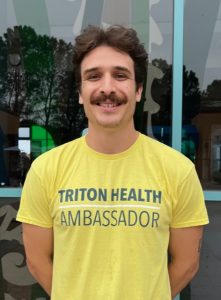
Matteo Biscotti characterized the chemical composition of the ocean around Scripps Pier using liquid chromatography and coupled mass spectrometry for analytical analysis. He collected seawater daily for a ten-day period as well as during days where anomaly conditions were present to obtain particulate organic matter, perform several variations of solid phase extraction for dissolved organic matter, and to extract organic carbon and nutrients.
Mentor: Ralph Torres, Grad student in the L. Aluwihare Lab
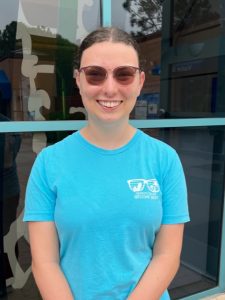
Elizabeth Burstein used NOAA CalCOFI Oceanographic Genomics data to study potential food sources for anchovy larvae in the California Current. She used R to find correlations between anchovy larvae counts and some of the widespread eukaryotic plankton, and identified some possible larval food sources.
Mentors: Drs. Andrew Barton, Alaina Smith, and Andy Allen; Grad student Rob Lampe
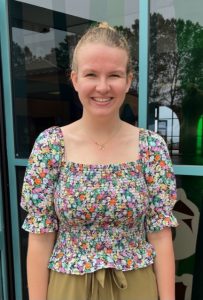
Meghan Kaschner studied prokaryotic and eukaryotic community structure and diversity in the California Current Ecosystem between 2014 and 2020. Using data from quarterly California Cooperative Oceanic Fisheries Investigation (CalCOFI) cruise eDNA sampling, she visualized temporal biomass and diversity variation in RStudio.
Mentors: Drs. Andrew Barton, Alaina Smith, and Andy Allen; Grad student Rob Lampe
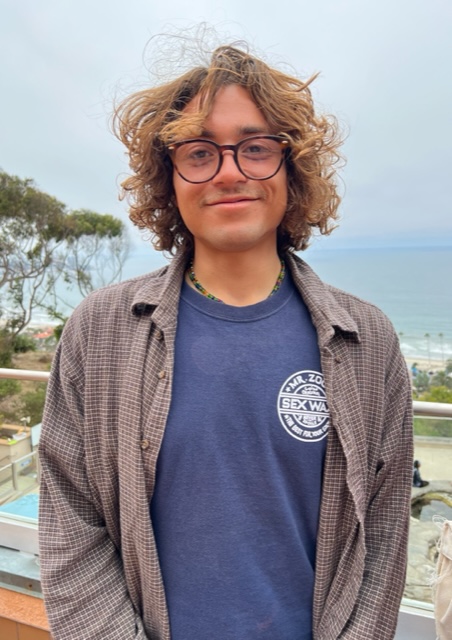
Carlo Makeever investigated the ecological responses to changing environmental conditions in the CCE as part of the REU program. Utilizing a numerical model and Matlab for data analysis, Carlo found that the model accurately represented how different types of plankton and nutrient levels respond to environmental shifts like El Niño events. The experience equipped Carlo with essential data analysis skills and inspired further research interests in marine ecology.
Mentors: Drs. Art Miller, and Colleen Petrik; Grad student Anthony Wilson
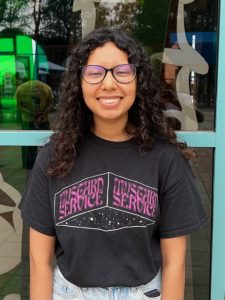
Angeles Rios investigated Baird’s beaked whale presence in locations throughout the North Pacific using passive acoustic data. Using programs in MATLAB, they identified and labeled the unique echolocation click of this species and created a time series for each site to gain an understanding of their spatio-temporal distribution.
Mentor: Michaela Alksne, Grad student in the S. Baumann-Pickering Lab

Jack Saade worked on ion selective electrode (ISE) design and housing manufacturing to optimize the cost and efficiency of pH measurement along the coast. He used LabView, Matlab, and SolidWorks to iteratively test different chemical compositions of the ISE and Solidworks to create a range of housings designed for high pressure environments.
Mentor: Taylor Wirth, Grad student in the T. Martz Lab
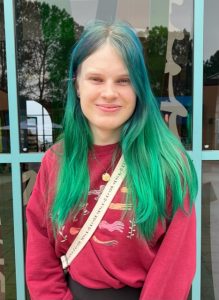
Iris Smryl studied physical-ecological models of microorganism populations in the Northeast Pacific. Using Python to read the model data outputs, they plotted individual snapshots of data, or animated a window of time to look at statistics from the data. This included seasonal cycles from monthly means, or anomalies in the data caused by physical changes to the environment.
Mentor: Art Miller, CCE Co-PI
2022
Flyer 1 | Flyer 2 | Flyer 3 | Flyer 4 | Agenda
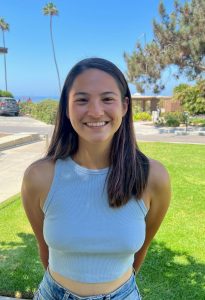
Hannah Budroe used DNA metabarcoding (mtCOI and 18s rRNA "barcodes”) to analyze patterns of zooplankton diversity and community composition from high volumes of complex samples in the California Current. She used R language to perform various ecological analyses to identify community clusters in zooplankton.
Mentor: Dante Capone, CCE Graduate student - M. Décima lab
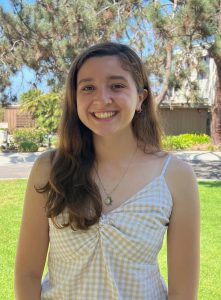
Maria Durazo studied the diel variability of marine metabolites, focusing on the analysis of various types of important compounds, mainly dissolved organic matter (DOM). She collected seawater samples from the SIO pier (4x/day) and obtained nutrients, dissolved organic carbon, and used a solid phase extraction method to retain and analyze the organic compounds.
Mentor: Ralph Torres, CCE Graduate student - L. Aluwihare lab

Kassadi Holloway investigated spatial changes in mesozooplankton grazing, researching zooplankton predation on phytoplankton and how they reacted to such changes (grazing pressure) along a coastal upwelling filament from inshore to offshore. She used gut fluorescence techniques to look at 5 different size fractions of mesozooplankton along the filaments to determine mass-specific grazing rates.
Mentor: Mark Ohman, CCE Lead PI

Zoie Jones studied baleen whale calls and fish vocal behavior (choruses) in La Jolla Canyon by analyzing data collected by a Zooglider, featuring a hydrophone. She used MATLAB to view the acoustic data, and then created visualizations in R to assess the diel periodicity of the calls and choruses produced, and where fish are in the water column.
Mentor: Annebelle Kok, CCE Post doc - S. Baumann-Pickering lab
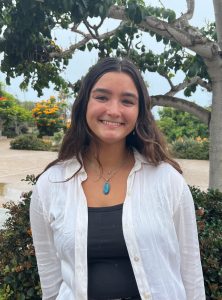
Katarina Kaminsky initially worked in the lab on DNA extracted from zooplankton at different depths using a vertical multinet from samples taken from across the North Pacific. She then performed data analysis utilizing DNA metabarcoding to assess the biodiversity and abundance of zooplankton from 3 regions in the water column at different latitudes.
Mentor: Stephanie Matthews, CCE Grad student - M. Ohman lab
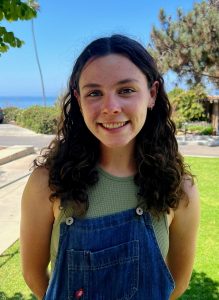
Kailey Ramsing researched growth of Synechoccocus isolates from the San Diego Bay at different temperatures to determine optimal temperature ranges. She also studied the survival and recovery of Synechoccocus isolates during and after periods of darkness to understand the dark tolerance on Synechoccocus.
Mentor: Brian Palenik, CCE Affiliate
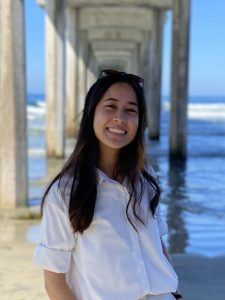
Kaitlyn Reardon used MATLAB to research important physical oceanographic factors related to upwelling and the upwelling season in the California Current System. She utilized geostrophic velocity satellite data and plots to look at regions along the CA coast where, on average, flow during the upwelling season is directed offshore, and temporal patterns in offshore flow probability at these locations.
Mentor: Shailja Gangrade, CCE Graduate student - P. Franks lab
2021
Flyer 1 | Flyer 2 | Flyer 3 | Agenda

Anna Mothersole researched species-specific trends in dolphin presence and absence while trying to answer if stock-specific echolocation clicks truly corresponded to two genetically distinct Pacific White-Sided dolphin populations - a northern and southern population, as well as Risso’s dolphins. She used passive acoustic monitoring (raw data) and generalized additive models in R using environmental data to gain some insight into the dolphins’ population distributions and habitat use.
Mentor: Michaela Alksne, Grad student in the S. Baumann-Pickering Lab (CCE-LTER Associate)
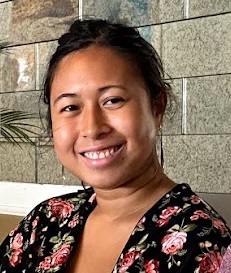
Charlene Ruiz researched changes in the phytoplankton phenology of harmful algal blooms, primarily four bloom-forming dinoflagellates, at the Scripps Pier, using data from SCCOOS' harmful algal bloom dataset (2012-present) and W.E. Allen's historic dataset (1919-1939). She compared and contrasted the two datasets using R, which allowed her to see how bloom phenology might have changed within the past century, especially in the timing of its peak abundance and seasonal peaks.
Mentor: Andrew Barton (CCE-LTER Associate)
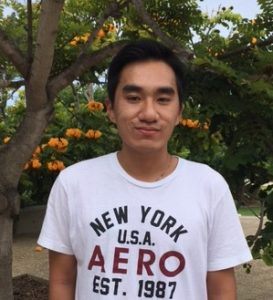
Bryant Tran worked on finding a causal link between marine animal stranding data and phytoplankton counts in the California Current Ecosystem, plus its surrounding regions. He focused his research on the pennate diatom Pseudo-nitzschia, variants of which are associated with harmful algal blooms. Using data analysis techniques, R, and Python, he plotted autocorrelation functions, correlation maps, and linear models of the data.
Mentors: Brice Semmens (CCE-LTER Associate) and Erin Satterthwaite (CalCOFI)

Anissa Garcia performed full diel dilution experiments off the Scripps Pier (La Jolla) and also participated in a CCE LTER Process Cruise for one month, to study the growth and grazing mortality rates of marine plankton in the ocean. The experiments were accomplished by incubating seawater at different dilution factors (whole seawater and filtered seawater ratios) and analyzing samples during a day and night cycle (12- and 24-hour periods).
Mentors: Darcy Taniguchi, CSUSM Assistant Professor (CCE-LTER Alum) and Sydney Plummer (CCE-LTER Grad student) while at sea
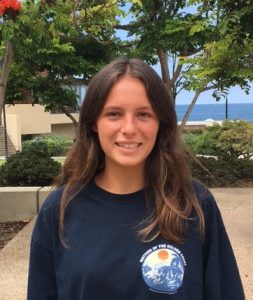
Chiara Hayes analyzed the growth rate of Synechococcus species at different temperatures, using isolates from San Diego Bay and the California Current. She also learned and utilized a pathway and genome database (BIOCYc) to determine the presence of genes and chemical reactions amongst the Synechococcus species being analyzed, determining potential differences to better understand how they might adapt and grow under different thermal conditions.
Mentor: Brian Palenik (CCE-LTER Associate)
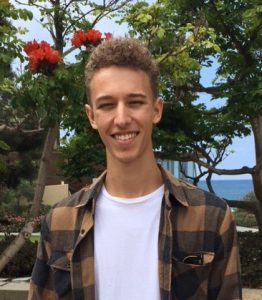
Marley Weiss measured trace levels of total dissolvable iron (TdFe) in seawater samples taken from the P1908 CCE process cruise, collected from various depths along the path of an upwelling filament near Pt. Sur. He used MATLAB and Ocean Data View software to gain insight on the spatial variations of iron levels in the open ocean and in near-shore, high productivity regions, adding to a more comprehensive understanding of the biogeochemistry of the region.
Mentors: Kiefer Forsch (CCE-LTER Grad student) and Kathy Barbeau (CCE-LTER Co-PI)

Victoria Burns developed a protocol for assessing pteropod shell dissolution, as they are an ecologically important type of planktonic gastropod, having fragile shells and susceptible to changing carbonate chemistry in the ocean. Using SEM and coding software, she looked at pteropod shell state (an iterative process) and developed a preliminary image analysis workflow to quantify the variable nature of dissolution of these important bioindicators.
Mentors: Moira Décima (CCE-LTER Associate) and Greg Rouse (Benthic Invertebrate Collection)
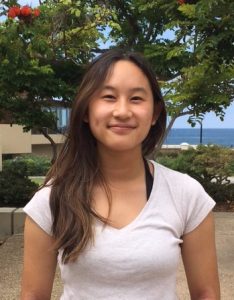
Sandy Nguyenphuoc utilized DNA barcoding techniques (amplified CO1 mtDNA and 16S ribosomal DNA genes) to identify and monitor California ichthyoplankton across five locations, assessing the biodiversity and abundance of pelagic spawning fish. She compared this to previous data collected from these sites (2019 and 2020) in order to elucidate patterns in diversity and egg abundance spatially (latitude) and temporally.
Mentor: Michaela Labare, Grad student in the R. Burton Lab (CCE-LTER Associate)
2020
Alicja “Ala” Najduch studied phytoplankton community composition off the San Diego Coast and used satellite imagery to provide contextual environmental information about conditions at the sample sites. Using genomic and transcriptomic techniques, she investigated community dynamics before, during and after bloom conditions, specifically focusing on the dinoflagellate Lingulodinium polyedra.
Mentor: Rob Lampe, CCE-LTER Graduate Student
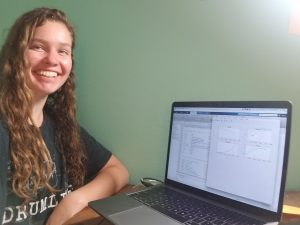
Iris Kubler-Dudgeon developed a model for mercury accumulation in phytoplankton to predict concentrations of mercury (a neurotoxin) as temperature and nutrient levels changed. Assimilation of mercury in phytoplankton is the entry point for mercury to accumulate in Pacific Ocean food-webs. It is important to predict mercury transfer into higher trophic levels and assist in managing health standards as our climate changes.
Mentor: Amina Schartup, CCE-LTER Associate

Nicolas “Nico” Concha-Saiz used previously collected data on zooplankton and micronekton in the CCE to examine several biological traits (size, weight, percent moisture, nitrogen, and carbon content) of five major animal groups (Arthropoda, Chordata, Cnidaria, Ctenophora, Mollusca), and he compared variability within and between taxa. His research will be useful for future estimates of biomass and carbon flow through the deep pelagic ocean.
Mentors: Elizabeth Hetherington, CCE-LTER Post-doc and Anela Choy, CCE-LTER Associate
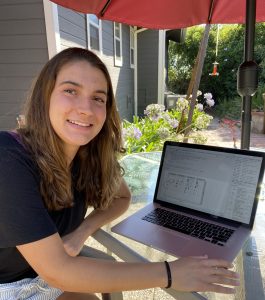
Juliet James focused on determining if the difference between modeled and measured carbon to chlorophyll a ratios could be used as a proxy to separate phytoplankton carbon concentrations and detrital carbon concentrations within the directly measured bulk suspended particulate organic carbon concentration. She found that, in general, this comparison seemed to provide a good estimate of detrital carbon concentration, and that the next step was to find other means of verification of these estimates.
Mentor: Lihini Aluwihare, CCE-LTER Co-PI
2019
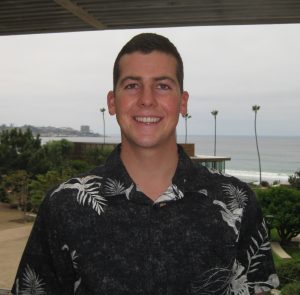
Garret Schmid worked on the Smartfin project in the Martz Lab, testing multiple pH sensors to understand their capacity to be incorporated within a small surfboard fin to aid in monitoring ocean acidification. He learned many things including basic electrical engineering skills, wrote software to communicate with microcontrollers, ran controlled experiments to test pH sensors, and built a few functioning Smartfins.
Mentor: Phil Bresnahan, Research Engineer
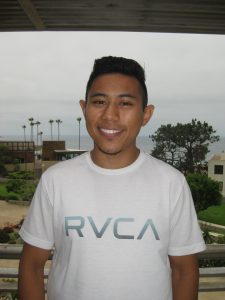
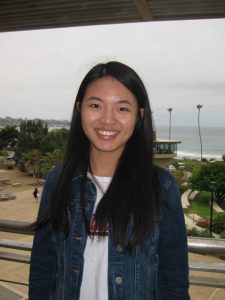
Lawrence “Rence” Balitaan and Yunchun “Pauline” Pan used MATLAB to plot and analyze 11 variables from the ROMS-NEMURO model to better understand biophysical interactions in the California Current System (CCS). Rence improved his limited coding skills and learned how to manipulate large data sets in MATLAB, while Pauline practiced her programming skills by extracting and manipulating data stored in 4D matrices. Together, they created composite plots of each biological or physical variable during El Niño and La Niña conditions, and analyzed each variable both individually and collectively to discover and characterize trends.
Mentors: Nathali Cordero-Quirós, Grad student, and Art Miller, CCE-LTER Co-PI
 Natalie Faivre collected fish eggs off the SIO pier with a plankton net, and identified them using DNA sequencing techniques. Piggybacking on previous students’ work, this allowed her to observe spawning patterns and begin to address the question of how climate change might affect species diversity and population numbers within the Marine Protected Area around the SIO pier.
Natalie Faivre collected fish eggs off the SIO pier with a plankton net, and identified them using DNA sequencing techniques. Piggybacking on previous students’ work, this allowed her to observe spawning patterns and begin to address the question of how climate change might affect species diversity and population numbers within the Marine Protected Area around the SIO pier.
Mentors: Emma Choi, Grad student, and Ron Burton, CCE-LTER Associate

Tristin Rammel used DNA techniques and bioinformatics software to analyze the microbial genetic diversity and abundance of various phytoplankton, mainly eukaryotic cryptophytes, off the Scripps Pier (over a 20 year period) and in San Diego Bay. He also used flow cytometry to analyze cryptophyte cell densities, and compared them with other relevant microbial taxa in CCE waters.
Mentors: Ivan Moreno, Grad student, and Brian Palenik, CCE-LTER Associate
2018
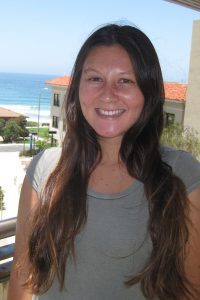
Emma Choi researched fish spawning trends in the Marine Protected Area off La Jolla by using DNA techniques in the Burton Lab. This consisted of collecting fish eggs, amplifying their DNA by PCR, and sending the DNA out to be sequenced for identification. This molecular method of identifying fish eggs complements data regarding local fish species obtained by diver surveys.
Mentors: Elena Duke, Graduate student, and Ron Burton, CCE-LTER Associate
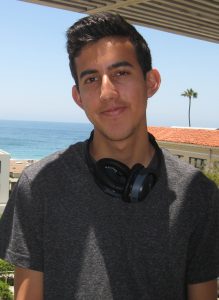
Fernando Gil created a quality control program with MATLAB, using several live scripts in the Martz Lab, to calculate the alkalinity of seawater samples from the underway CalCOFI samples. After creating a 3-point regression and applying corrections, he calculated the pH of the seawater from various CalCOFI stations off the coast of southern California. Fernando also created a chart to show which components of this system were functioning at any given time along the path of the cruises.
Mentor: Todd Martz, CCE-LTER Associate
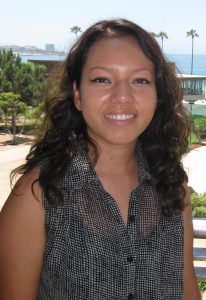
Sara Ramirez at habitat suitability modeling for the California market squid in the Miller Lab, and applied the concept to spawning suitability. Because market squid are restricted by their environment during spawning, the model was constructed using the species-environment relationships of bathymetry, substrate affinity, and temperature - ranking spawning zones on how suitable it is based on those criteria.
Mentors: Nathali Cordero-Quiros, Graduate student, and Art Miller, CCE-LTER Co-PI
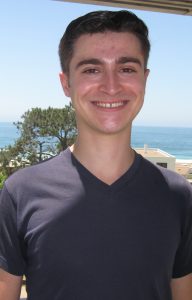
Niv Anidjar measured dissolved iron concentration in seawater samples in the Barbeau Lab, taken during process cruise P1706. He used these concentrations along with ADCP velocity data in order to determine values for cross-shore advective flux of dissolved iron, as these measurements are useful for understanding changes in distribution of primary producers. Iron is episodically the limiting nutrient in the CCE, which can restrict growth of plankton.
Mentors: Kiefer Forsch, Graduate student, and Kathy Barbeau, CCE-LTER Co-PI

Kellie Lemoine studied the role of siderophores in microbial iron acquisition in the Barbeau Lab. Siderophores are compounds that strongly bind and transport iron in microorganisms. Through experimentation in the lab, she found that siderophores may play a significant role in helping bacteria take up inorganic iron in the California Current Ecosystem, an area where upwelling may be a source of sedimentary iron.
Mentors: Lauren Manck and Sara Rivera, Graduate students, and Kathy Barbeau, CCE-LTER Co-PI
2017
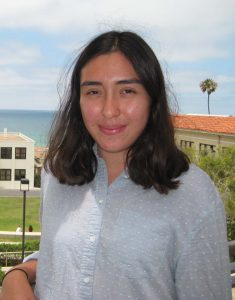 Cristina Curiel analyzed physical and biological model data results generated by an ocean computer model (Darwin model) from the CCE region. She worked in Art Miller’s group, defining characteristics of different phytoplankton and zooplankton groups. Her project focused on ocean eddies, and the associated edges of the eddies known as fronts, comparing computer model results with field measurements. analysis, under iron limited conditions.
Cristina Curiel analyzed physical and biological model data results generated by an ocean computer model (Darwin model) from the CCE region. She worked in Art Miller’s group, defining characteristics of different phytoplankton and zooplankton groups. Her project focused on ocean eddies, and the associated edges of the eddies known as fronts, comparing computer model results with field measurements. analysis, under iron limited conditions.
Mentors: Art Miller, CCE-LTER Co-PI

Gabriela Haddad studied spawning patterns of fish in two habitats of our local Marine Protected Area, using DNA sequencing to identify fish eggs in the Burton Lab. Fish species compositions, spawning periods and habitats, and environmental effects were analyzed for nearby kelp forest and Scripps pier samples.
Mentors: Mentors: Elena Duke, Graduate student, and Ron Burton, CCE-LTER Associate

Aysell Medina studied heterotrophic bacteria from the CCE-P1706 coastal filaments cruise, working in the Aluwihare Lab. She measured bacterial abundance and size in comparison with previous years. She used a variety of lab techniques, including DNA staining to calculate the carbon content for each cell.
Mentors: Sara Rivera, Graduate student, and Lihini Aluwihare, CCE-LTER Co-PI.

Kaytlyn Taglialavore working in the Aluwihare Lab, analyzed seawater's Fluorescent Dissolved Organic Matter (FDOM) characteristics in the California Current Ecosystem on samples collected during the CCE-P1706 cruise. She subsequently used MATLAB to identify key chemical components within the CCE's FDOM and focused her analysis on the distributions of these components relative to distance offshore, DOC concentration and depth.
Mentors: Brandon Stephens, Graduate student, and Lihini Aluwihare, CCE-LTER Co-PI

Maggie Wang analyzed Synechococcus diversity in the California Current Ecosystem using filters collected at sea at four different locations on the P1604 cruise. She worked in the Palenik Lab and used molecular techniques to compare inshore vs. offshore clades of cyanobacteria as well as variations with depth.
Mentors: Maitreyi Nagarkar, Graduate student, and Brian Palenik, CCE-LTER Associate
2016

Bretton Coppedge studied iron uptake in a marine bacterium, Alteromonas macleodii, and created a gene similarity network that helped identify which genes Alteromonas most likely uses to take up iron. She also analyzed the expression of these genes through qPCR analysis, under iron limited conditions.
Mentors: Lauren Manck (Grad student) and Kathy Barbeau (CCE LTER Co-PI)
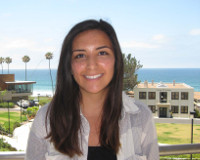
Elena Duke researched the spawning activity of fish populations in two of San Diego’s Marine Protected Areas using DNA barcoding techniques. She was able to decipher seasonal changes in spawning activity from the data and changes in community composition over time.
Mentors: Alice Harada (Grad student) and Ron Burton (CCE LTER Assoc. PI)

Wiley Wolfe's goal this summer was to determine the short-term chemical spatiotemporal variability of Agua Hedionda Lagoon. He did this using a paddle board with a WavepHOx sensor attached, along with a GPS watch to record the time and location of each measurement.
Mentors: Taylor Wirth (Staff Res. Assoc.) and Todd Martz (CCE LTER Assoc. PI)
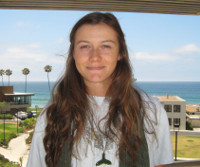
India Dove analyzed multi-decadal changes in microplastic sedimentation rates in the anoxic Santa Barbara Basin, researching whether microplastic sedimentation rates changed over a century timescale and whether there was a distinct time horizon when plastic first emerged in the sediments. She enumerated, imaged, measured, and recorded various characteristics in over 1,100 microplastic pieces extracted under the microscope.
Mentors: Jennifer Brandon (Grad student) and Mark Ohman (CCE LTER Lead PI)
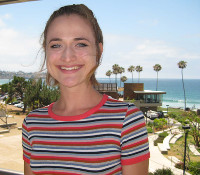
Brooke Rasina focused her study on the heterotrophic bacteria in the California Current Ecosystem, testing whether El Niño had an effect on bacterial abundances and bacterial carbon content. The abundance and carbon data from Process cruise P1604 (El Niño year) were compared to similar data from P0605 (normal year), P0704 (normal year) and P1408 (“Blob” year).
Mentors: Sara Rivera (Grad student) and Lihini Aluwihare (CCE Co-PI)

Casey Graff studied machine learning techniques for the automatic classification of digital zooplankton images. He wrote computer algorithms to help classify and quantify plankton images to further understand plankton distributions, create oceanographic models, and study population ecology. Automating this process can help save significant time and resources.
Mentors: Jeff Ellen (Grad student) and Mark Ohman (CCE LTER Lead PI)
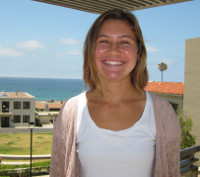
Jennifer Beatty estimated the ciliate biomass in the California Current during the “Blob” (P1408) and El Niño (P1604) warm water anomalies. Ciliates are heterotrophic plankton that represent up to one third of the heterotrophic biomass in the California Current. They are extremely fragile, so she used a different filtering process than other plankton, counted ciliate cells and calculated the carbon biomass from each cruise year.
Mentors: Ali Freibott (Grad student) and Mike Landry (CCE LTER Lead PI)
2015
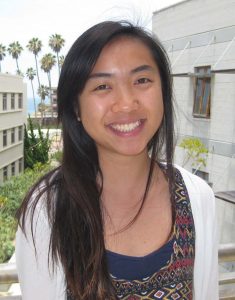
Linda Tong studied mesozooplankton grazing via gut fluorescence in the Ohman lab this summer. She analyzed zooplankton gut samples from CCE Process Cruise P1408, examined possible factors affecting spatial variability in mesozooplankton grazing, and sought to determine an appropriate metric for approximating the factor of food concentration. Linda gained invaluable experience and knowledge, and a better appreciation for the CCE through her work.
Mentors: Jenni Brandon, Graduate student & Mark Ohman, CCE-LTER Head PI

Raul Martinez performed trace metal analysis in the Barbeau lab this summer. Specifically, he collected and looked at copper levels in San Diego Bay and off the SIO pier to determine levels of toxicity. The study included characterizing copper-binding organic ligands with electrochemical measurements using CLE-ACSV. Raul gained a better understanding of chemistry and how data are analyzed to determine copper and ligand concentrations.
Mentor: Angel Ruacho, Graduate student

Maria Winters worked in the Miller lab on a physical oceanography modeling project regarding eddies. She analyzed output from a combined biological-physical model of the CCE, which represented changing populations of plankton in the CCE over time, as well as changing physical variables. Maria improved her MATLAB skills, which helped to better understand and improve the model to represent the CCE, one of the most productive ecosystems in the world.
Mentor: Art Miller, CCE-LTER Co-PI

Vivian Han focused her studies in the Palenik lab on the population dynamics and the clade distribution of Synechoccocus, an ecologically important cyanobacteria. She collected seawater samples at the SIO pier, and used genetic techniques to create the clade libraries. Vivian also investigated whether Gymnodinium, a genus of photosynthetic dinoflagellates, grazed on Synechoccocus via co-culture experiments.
Mentor: Maitreyi Nagarkar, Graduate student & Brian Palenik, CCE-LTER Assoc-PI
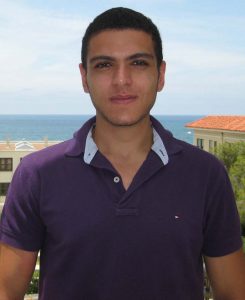
Abdalrahman Alrayyes worked with the CalCOFI folks (Goericke lab) as a data analyst sorting through decades of pH data to confirm that the data were true from CalCOFI cruises, or to decipher new relationships that could allow one to better understand the ocean’s chemistry. He ended up investigating how factors such as nitrate and oxygen contents are related to pH after discovering the pH sensors were faulty, having to draw on theoretical data to make calculations.
Mentor: Ralf Goericke, CCE-LTER Co-PI
2014
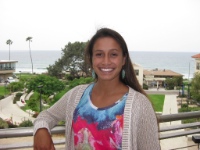
Kyra Rashid worked the first part of the summer in Mike Landry’s Lab, investigating how climate change influenced microplankton community distribution and dynamics through work in the lab. She spent the last month at sea on the CCE P1408 Process Cruise and became familiar with the design, execution, and analysis of dilution experiments which are a means of calculating community growth and grazing rates, as well as taking part in various types of oceanographic sampling with the scientists.
Mentor: Ali Freibott, Graduate student
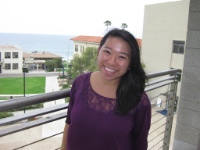
Kari Ann Yoshida spent the summer performing guided research in Brian Palenik’s Lab on the survival of the marine cyanobacterium, Synechococcus, at differing ocean depths. She created various clone libraries of Synechococcus DNA by isolating specific sequences extracted, amplified, and cloned through molecular methods, and observed relative preferences of clades in surface and deeper waters.
Mentor: Maitreyi Nagarkar, Graduate student
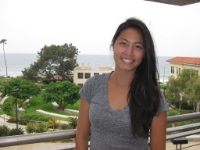
Jasmine Tan worked in Farooq Azam’s Lab measuring protein synthesis rates of bacteria and converting synthesis rates into bacterial carbon productivity via leucine incorporation and centrifugation. She also tested how to best store bacterial samples, and spent the last month on the CCE P1408 Process Cruise, collecting seawater samples from various depths at different stations in the CCE for later analysis.
Mentor: Byron Pedler Sherwood, Post-doc
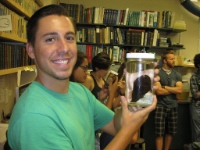
Taylor Wirth spent the summer working in the Todd Martz Lab, where autonomous ocean sensors are developed, most notably the SeapHOx pH & oxygen sensor. Taylor designed a lighter, smaller, and more hydrodynamic housing for this sensor (called WavepHOx), along with a rechargeable battery pack, which can be used on Wave Gliders and SUPs in the near-shore environment. Taylor also participated in some local field testing of the WavepHOx!
Mentor: Phil Bresnahan, Graduate student
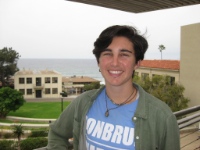
Maya Land worked in Mike Landry’s Lab earlier in the summer, learning a relatively new method of secondary production estimation of the molting enzyme, chitobiase. She implemented this method on the CCE LTER research cruise in August (P1408) to measure the chitobiase-based production rates of crustacean zooplankton communities.
Mentor: Moira Décima, Post-doc
2013

Alicia Highland researched mesozooplankton grazing rates across oceanic fronts in the California Current Ecosystem (CCE), with major emphasis on pelagic copepods. The aim of the research she conducted was to determine whether zooplankton grazing upon phytoplankton changes along the frontal boundaries, and utilized the gut fluorescence method in order to measure chlorophyll pigments.
Mentor: Dr. Mark Ohman

Ana-Patricia Lopez learned how to use an ecosystem model for quantifying spatial structures of phytoplankton and their relationship to ocean currents, waves and ocean fronts, through data manipulation of large data sets. This helped her learn whether the simulations resembled real observations and how to diagnose the physical controls of the ecosystem.
Mentor: Dr. Art Miller
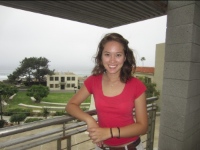
Anna Cassady studied the effects of secondary metabolites from each of four strains of the marine cyanobacterium, Synechococcus, in supernatant on the development of other strains. She also measured the effect these secondary metabolites had on sea life communities off the SIO pier. The experiment was monitored by using both microscopy and flow cytometry in the lab.
Mentor: Dr. Brian Palenik
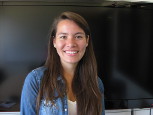
Emma Nuss investigated the relationship between biological activity in the ocean and physical processes, in particular eddy currents, by studying the output of a Darwin model. Her main question focused on what happens to phytoplankton in an eddy off the Southern California Coast.
Mentor: Art Miller

Jenny Couture worked on a project that investigates our ability to assess the state of the ocean. More specifically, she carried out a meta-analysis on Pacific Ocean observation programs to determine where and how the physics, chemistry, and the biology of the ocean are measured. While some measurements were adequate, biological monitoring was severely lacking or inconsistent in her findings.
Mentor: Dr. Tony Koslow
2012

Aarani Arulmoli studied how bacteria are involved in the biogeochemical cycling of iron, using metagenomic analysis of the microbial community in environmental samples, and in iron addition grow-out incubations. Aarani constructed a clone library using various DNA techniques in the Barbeau Lab, becoming familiar with each step in the process to prepare plasmids for analysis, along with how to make phylogenetic trees to evaluate bacterial community composition.
Mentor: Dr. Kathy Barbeau
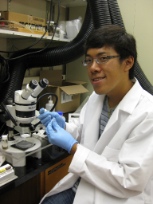
Dustin Chen tested the validity of the “school trap” hypothesis of three fish species (Pacific sardine, chub and jack mackerels) in the Checkley Lab, using MATLAB to analyze a dataset containing egg and larval concentration data spanning from 1951 to 2010. Historical habitat overlap between sardine and either mackerel species were investigated using correlation analyses with three proxies for sardine population levels. Dustin also started a diet comparison study of locally collected Pacific sardine and chub mackerel.
Mentor: Rebecca Asch, Graduate student
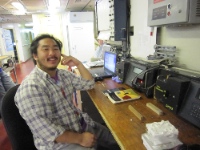
Jonathan Cheng spent the first part of the summer in the Azam Lab studying marine bacteria and the role they play in the biogeochemistry of the ocean. He focused on measurement rates of bacterial carbon production, using a radioisotope incorporation technique. Jon then participated on the 30- day CCE process cruise (P1208), gathering and filtering samples for bacterial community growth analysis, along with helping out other CCE scientists on their shipboard projects.
Mentor: Ty Samo, Graduate student
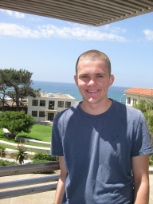
David Muller worked in the Martz Lab, which specializes in developing autonomous chemical sensors for the ocean, mainly to measure pH. David spent many hours overhauling the software that interfaces with an autonomous SeapHOx instrument package (3 sensors and a converter) and updated an older computer to run the software. He honed his software skills putting all the code together and learned a lot about electrical engineering and digital circuit design as well!
Mentor: Dr. Todd Martz
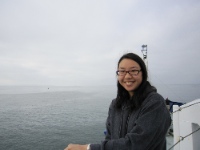
Carole Wang interned the first part of the summer in the Palenik Lab focusing on Synechoccocus, a marine cyanobacterium. She tested whether external stressors (sugars and other chemicals) to Synechoccocus cultures could induce or disrupt the formation of micro-colonies (clumping behavior), analyzed with epifluorescence microscopy and fluorometer readings. Carole also participated in the month-long CCE process cruise (P1208), assisting the Landry Lab with water sample collection from the CTD Rosette and from drifters – for phytoplankton and grazers’ incubation studies.
Mentor: Dr. Brian Palenik
2011
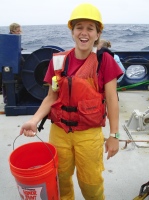
Kayla Blincow analyzed data collected from the Oozeki net (on CalCOFI cruises) to map euphausiid communities in the California Current. She also went to sea for several weeks on a CalCOFI cruise (1108) as the “Oozeki technician.” Continuing with her project back at SIO, she identified euphausiids to the species level and counted the number of each species from the cruise samples, estimated the abundance of each type of species, and mapped their community structure based on where the sample was collected.
Mentor: Dr. Tony Koslow

Lisa Della Ripa conducted research which involved comparing and assessing the trophic positions of zooplankton in three different biogeochemical environments, using various lab techniques. She spent one month at sea in the CCE study area, and a week at sea in Hawaii. Lisa investigated differences in δ15N between the 0.2-2 mm size fractions and in the source nitrogen between the three regions and assessed whether the absolute trophic positions were different between regions.
Mentor: Dr. Mike Landry

Evelyn Hunter created a database which included data from the ALF (Advanced Laser Fluorometry) device and underway data from CCE-LTER cruises. She wrote and ran functions in MATLAB to consolidate and organize numerous smaller text files into one complete file, which were then imported into a Microsoft Access database. Evelyn also assisted with some CCE process cruise (P1106) preparations.
Mentor: Dr. Ralf Goericke
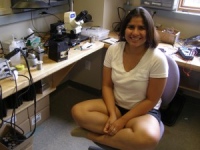
Melinda Lopez spent the summer creating additional software functionalities for a program running within an autonomous instrument package (SeapHOx), constructed in the Martz lab. She was able to program, calculate, and display the pH by using certain measured or user input pH calibration sensor coefficients (i.e. temperature and salinity).
Mentor: Dr. Todd Martz
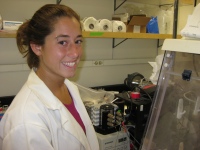
Wendy Plante participated on a one-month research cruise (P1106) and studied the role of Iron in the CCE study area. She assisted in casting the trace metal clean rosette, filtered samples, and ran experiments to examine how Iron affected the prevalence of primary producers. Back at SIO, Wendy ran Iron (II) lifetime experiments and compared the oxidation rate of Iron (II) in the water samples collected on the ship.
Mentor: Dr. Kathy Barbeau
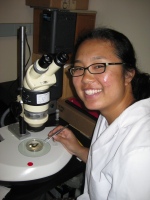
Ellen Umeda also participated on the CCE Process cruise (P1106) for one month. She assisted with the deployment and recovery of the bongo and MOCNESS tows, anesthetized and size fractioned the zooplankton samples caught, and placed them in liquid nitrogen for gut fluorescence and biomass analysis. Back on land, Ellen compared vertical distribution and life history stages of pyrosomes – for which she sorted, measured, and calculated densities from the MOCNESS tows.
Mentor: Dr. Mark Ohman
2010
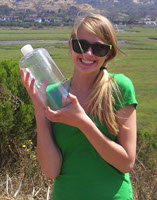
Kayla Busby examined the seasonal and geographical diversity of Synechococcus sp. CC9311, using qPCR techniques, with a focus on the environmental prevalence of an operon that is upregulated in this abundant marine cyanobacterium in response to copper shock. Samples from the SIO pier, local estuaries and coastal sites were analyzed.
Sponsor: Dr. Brian Palenik's lab
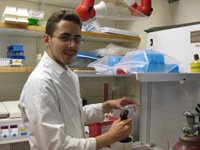
Ross Castillo used numerous techniques required to better understand aspects of iron cycling in marine systems. He combined wet lab experiments with bioinformatics when developing degenerate primers and identifying proteins of interest to study acquisition of heme as an iron source by marine bacteria.
Sponsor: Dr. Kathy Barbeau's lab

Chelsea Didinger participated on a research cruise. She assisted with equipment deployments and recovery, sample preservation, and designed and ran experiments to measure the ammonium excretion rate of euphausiids using a fluorometric method. Back in the lab at SIO, she also conducted excretion experiments with copepods.
Sponsor: Dr. Dave Checkley's lab
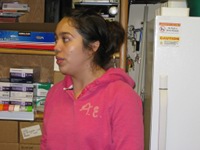
Danielle Lara examined concentrations of carbohydrate levels in seawater samples, collected on a 2008 CCE LTER Process cruise, using diverse lab techniques. Concentrations at various depths of the water column were then examined for trends. Sponsor: Dr. Lihini Aluwihare's lab
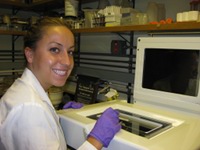
Emilie Schnarr compared oceanic and reef-associated zooplankton selected by the yellowtail damselfish from various reef habitats surrounding the island of Moorea. By examining stomach contents with a microscope and prey item size with ZooScan and ZooProcess, the number, diversity, type, and size of zooplankton was determined.
Sponsor: Kate Hanson (Graduate student)

Laura Cummings and Hank Lin were partner REUs from the NSF-sponsored Computer Vision Coral Ecology project. Sponsors for Laura and Hank were Graduate student Ben Neal (Scripps Photobiology Group, G. Mitchell Lab) and Post-doc Tali Treibitz (Computer Science Engineering, UCSD), respectively.*
2009
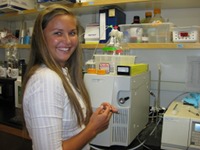
Nadija A. Anderson investigated the role of iron and silica as limiting nutrients for phytoplankton growth in the California Current Ecosystem, and analyzed samples using nutrient-amended incubation studies on the Scripps pier.
Sponsor: Kathy Barbeau's lab
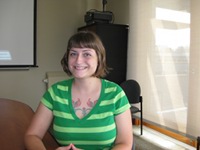
Emily Botts compared the diversity of coastal versus offshore populations of the marine cyanobacteria - Synechococcus, a diverse genus of phytoplankton, from a CalCOFI cruise using the high-resolution melting technique of DNA.
Sponsor: Brian Palenik's lab
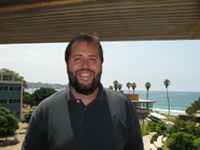
James Hayes gathered information management materials from 26 LTER sites, which involved documenting information systems development, data handling, and changes associated with technology and with the roles of information management. His work will support research on the development of site-based infrastructure. Sponsor: Karen Baker's Informatics Team
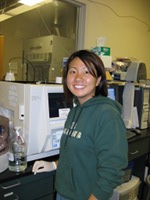
Patricia Lee quantified the total organic carbon (TOC) content in samples that were collected on a CCE LTER 2008 Process cruise, using a high-temperature catalytic oxidation (HTCO) method and a nondispersive infrared sensor.
Sponsor: Lihini Aluwihare's Lab
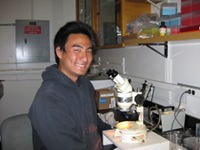
Junna Murakawa analyzed the grazing rates of mesozooplankton (sized ~ .2 mm to 5mm) from various locations within the CCE (2008 Process cruise) by looking at the level of extracted chlorophyll a pigments from phytoplankton remaining in their guts.
Sponsor: Mark Ohman's lab

Robert Peterson implemented a geographic dictionary (a gazetteer) designed to be integrated into an existing information system and also initiated development of a history module that incorporates a timeline of events designed to enable the capture of project narratives.
Sponsor: Karen Baker's lab
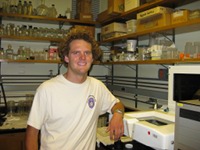
Tim Stillinger worked on correlating in situ acoustical backscatter data of zooplankton samples collected with an Acoustic Doppler Profiler (ADP) to zooplankton biomass estimates, which required digitizing zooplankton samples with Zooscan and identifying many, many species.
Sponsor: Mark Ohman's lab
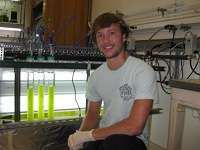
Elliot Weiss extracted water-soluble photosynthetic pigments called phycobiliproteins, from Scripps pier water samples using modified lab techniques, and used relative fluorescence to determine their presence (community structure) over the course of the summer.
Sponsor: Greg Mitchell's Lab
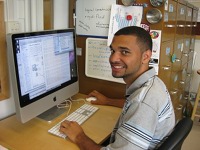
Sean Wiley gained loads of experience with the Ocean Informatics Team - programming languages, designing and implementing programs (information and data associated with the LTER Network), technical skills to program backend databases/software, as well as interact with the users of the databases/software.
Sponsor: Karen Baker's Informatics Team
2008
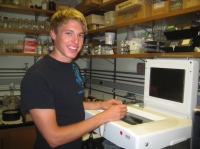
Todd Langland studied the relationship between size measurements of zooplankton using a Zooscan machine, and the carbon and nitrogen content of the organisms.
Sponsor: Mark Ohman's lab
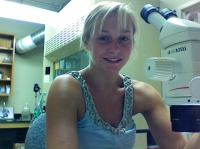
Mary McCormick researched how changing environmental factors alter food webs by analyzing the nitrogen isotopes in tissues of three species of small animals that are common in the California current.
Sponsor: Michael Landry's lab

Lisa Kamino examined the quality of nitrogenous marine organic matter by identifying retention times and content of amino acids in water samples, and studied the cycling of organic N in marine environments.
Sponsor: Lihini Aluwihare's lab

Emy Daniels focused on identifying grazers of an important marine bacterium, Synechococcus - and created a DNA "library" of ciliates using PCR and cloning techniques. Emy also participated in a CalCOFI-LTER research cruise, helping scientists with various hydrographic projects at sea.
Sponsor: Brian Palenik's lab
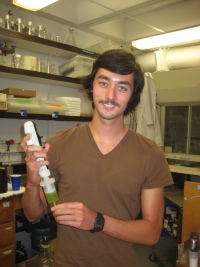
Brian Pearson created and improved upon a method to test for the presence of phycobiliproteins (photosynthetic pigments) in ocean samples. It was then used as a biochemical method to validate a new, faster instrument in identifying phycobiliproteins, found mostly in cyanobacteria and red algae.
Sponsor: Greg Mitchell's lab
2007
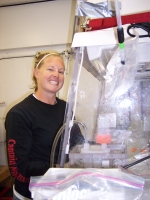
Randelle Bundy investigated iron light co-limitation of deep chlorophyll max communities.
Sponsor: Kathy Barbeau's lab
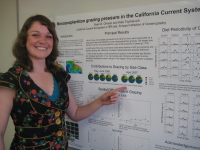
Kate Tsyrklevich focused on mesozooplankton grazing as assessed from gut fluorescence measurements.
Sponsor: Mark Ohman's lab
